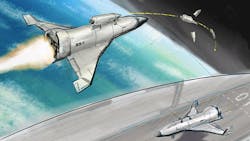Experimental Spaceplane Designs Foresee Everyday Operability
To help make space operations more routine, responsive, and affordable, the U.S. Defense Advanced Research Projects Agency (DARPA) created the Experimental Spaceplane (XS-1) program. The program serves to develop a fully reusable unmanned vehicle that would bring aircraft-like access to space. When completed, the plane would deploy small satellites into orbit via expendable upper stages. DARPA recently awarded prime contracts for phase one of the program to Boeing (working with Blue Origin), Masten Space Systems (working with XCOR Aerospace), and Northrop Grumman (working with Virgin Galactic).
Phase one includes development of the XS-1 demonstration vehicle; identification and conducting of critical risk reduction of core component technologies and processes; and development of a technology maturation plan for the system’s fabrication and flight test capabilities. The plan seeks a reusable first stage that would fly to hypersonic speeds at a suborbital altitude. Then, one of the expendable upper stages would separate and deploy a satellite into Low Earth Orbit (LEO).
The reusable first stage would subsequently return to earth and be prepared for its next flight. Reuse of the modular components and durable thermal protection systems, along with automatic launch, flight, and recovery systems, would help reduce logistical needs and enable more rapid turnaround between flights. This would also help reduce the cost of access to space for 3000-5000-pound payloads to less than $5 million per flight.
Check out an XS-1 concept video from DARPA below:
The XS-1 program includes other technical goals, such as the ability to fly 10 times in 10 days, flying Mach 10+ at least once, and launching a representative small payload to orbit.
About the Author
Iliza Sokol
Associate Digital Editor
Iliza joined the Penton Media group in 2013 after graduating from the Fashion Institute of Technology with a BS in Advertising and Marketing Communications. Prior to joining the staff, she worked at NYLON Magazine and a ghostwriting firm based in New York.
